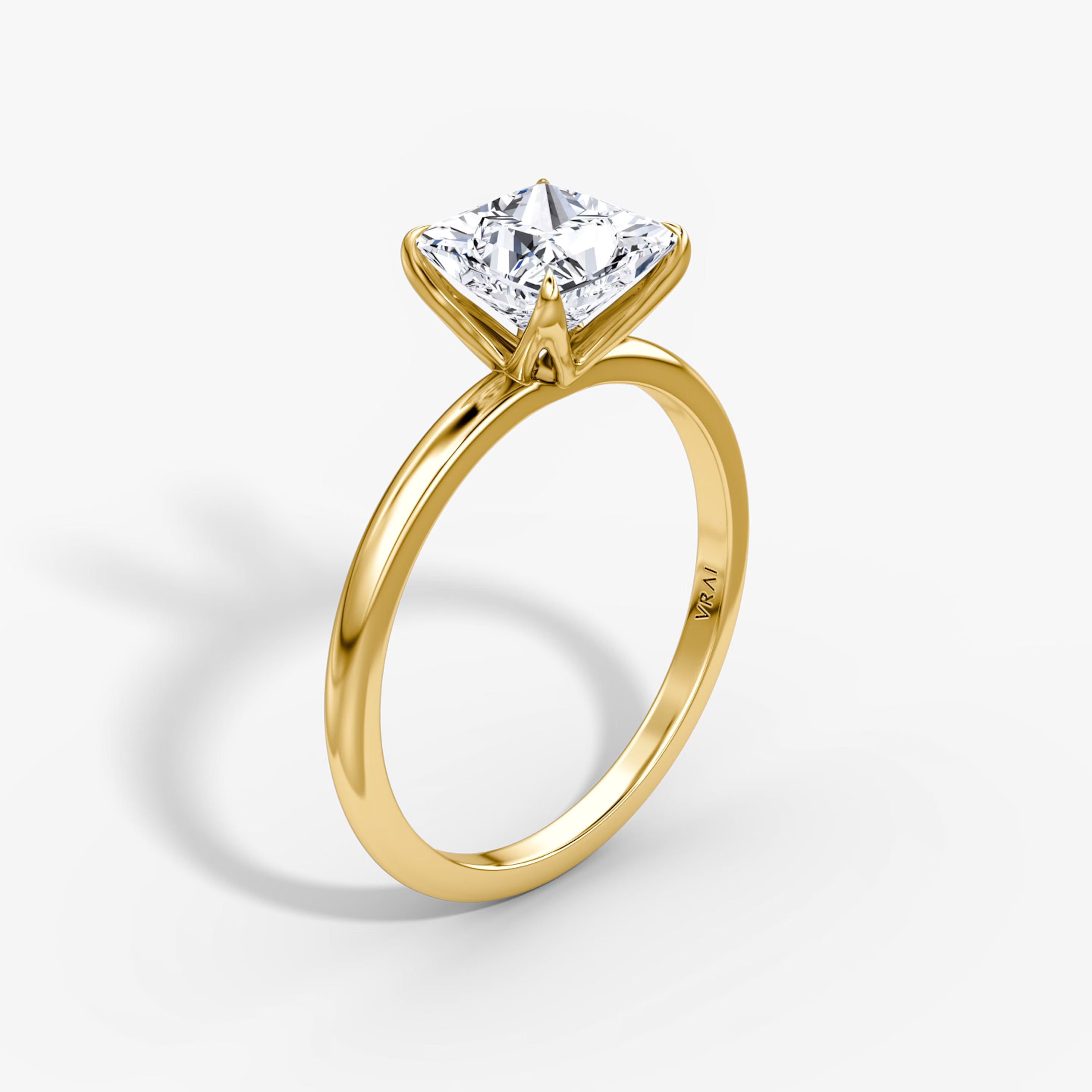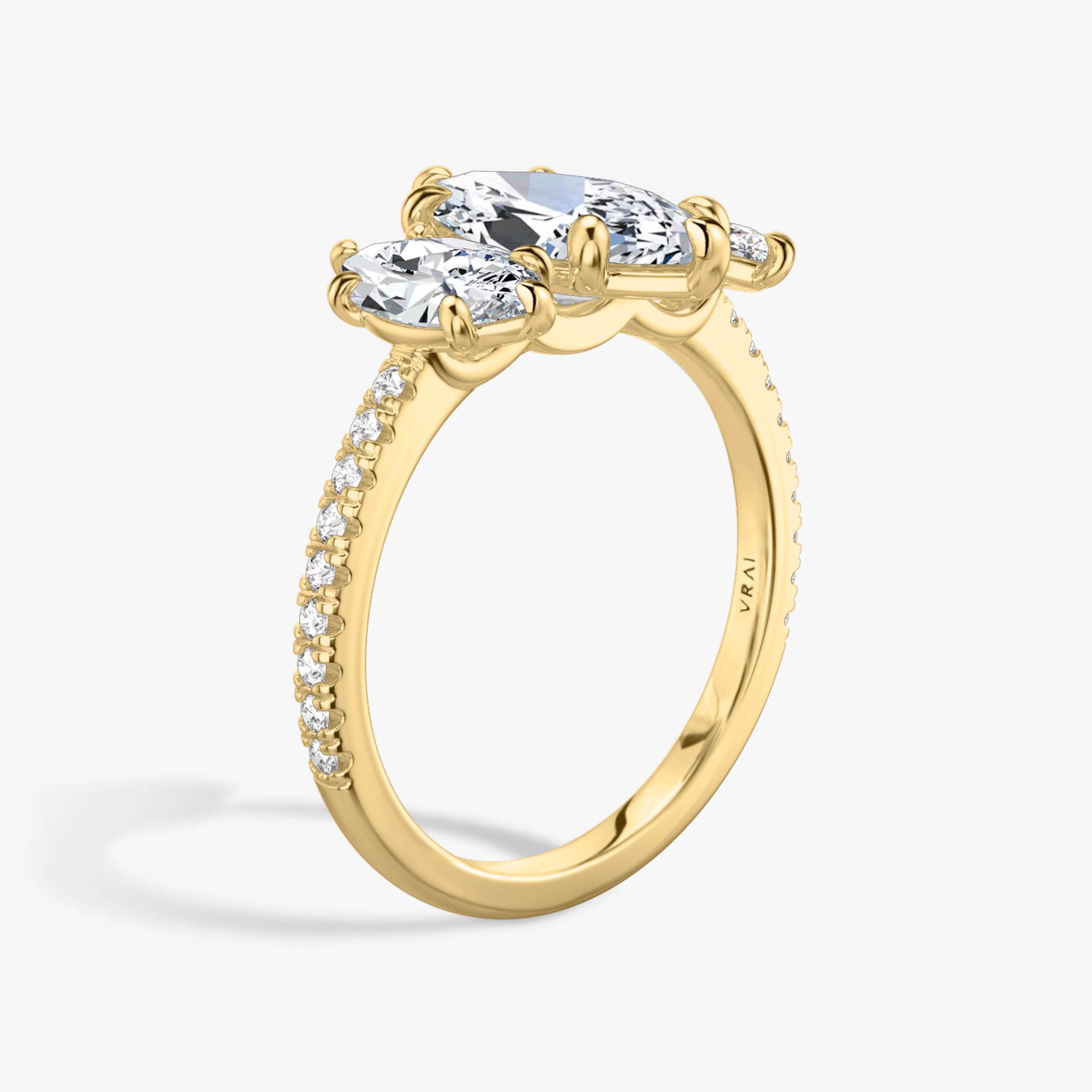Impeccable origin


High vs Low Set Engagement Rings: Which One Is Right for You?
Angelica Frey | December 13, 2023
When it comes to choosing an engagement ring, the type of setting is as important as the center diamond. Sure, you might have strong opinions on diamond shapes, and passionately argue in favor of Rounds, Ovals, Emeralds, Marquises, or other shapes.
Keep in mind that the way each stone will look and feel once mounted onto the band will be dramatically different depending on whether you land on a high or low-set ring. Before you decide on which setting works for you, consider the main characteristics and the pros and cons of high and low-set engagement rings featuring lab grown diamonds from VRAI.
What Is a “Setting” in an Engagement Ring?
An engagement ring setting refers to the way the stones are mounted onto the band. In the case of rings featuring VRAI created diamonds, setting is used interchangeably with “style”, and it indicates its type (solitaire vs three-stone; halo vs bezel), the number and orientation of the prongs (four-prong, six-prong, compass), and its height (high vs low).
How Do You Distinguish Between High and Low Settings?
There is no exact mathematical formula to determine whether a setting is high or low, but you can easily discern it with the naked eye. Just look at a ring from the side. If the center stone appears particularly elevated (almost as if it were “hovering” above the band), then that’s a high-set ring.
Conversely, if a stone whose culet or base almost appears “encased” in the band, this qualifies as a low-set ring. It’s worth noting that unless you’re wearing an inlay or channel-set ring, all stones will protrude slightly, as they’re three-dimensional objects whose height is greater than the band’s depth.
Characteristics of High Settings
A high-set ring features an elevated center stone, and a significant amount of space between the culet (the bottom pointed tip of a diamond or stone) and the band. A high setting emphasizes the diamond’s brilliance, as the diamond looks larger when viewed from above. VRAI’s Classic line highlights the benefits of a high settings.
Characteristics of Low Settings
In a low-set ring, the center stone sits lower and closer to the finger and band. Sometimes the setting appears to be particularly low because the band features a slight dip to accommodate it. This is the defining characteristic of VRAI’s Signature line, which has a sling that dips slightly below the band for an ideal balance between wearability and maximized brilliance.
Be the first to know
Hear about our latest designs and upcoming events.
How Do You Choose the Right Setting for You?
When choosing the setting of your ring, the two main factors are personal aesthetic preferences and lifestyle.
“Think about your lifestyle and the way you want to wear your jewelry,” advises Grace Taylor, VRAI’s Sr. Director of Sales and CX.
Do you work with your hands in something that is rough or messy? “A lower set ring is probably the way to go,” she says.
Are you sitting at a desk all day typing on your computer? “A high set style will probably not be a problem.”
On the aesthetic front, think about whether you like ring stacks that sit flush. Do you need a wedding band that fits flush or are you ok with a bit of a gap?
High Settings: Pros and Cons
The popularity of high engagement ring settings dates back to the turn of the 20th century and was centered on the idea of having one main center diamond. Settings, not just the band, became more complex and ornate. Additional ornamentation around the diamond was only possible with a higher setting.
A tall setting will make your chosen diamond look larger and maximize its brilliance, as the high setting will allow light to enter (and bounce) from all directions. A high setting will also allow a wedding band to sit flush. This means it will easily tuck up underneath, which many people prefer.
High settings are not ideal for elongated shapes and higher carat weights. “Elongated shapes in really high settings can be a little awkward in that the edges of the diamond might hang out more and get caught on things,” warns Taylor.
Low Settings: Pros and Cons
Low settings are more protective of the stone. Low settings also make it more difficult for the prongs to catch onto things. They work particularly well with modern, more delicate designs that take inspiration from nature.
On the flip side, low settings generally are not going to mesh as easily with a wedding band. “This was fine in the past when people opted to wear their engagement rings solo – sometimes just bringing them out when they dressed for dinner – or wearing a wedding band on a different hand,” says Taylor.
Now that people like to create ring stacks, combining engagement rings, wedding rings, and milestones rings, a low setting can limit the stacking options in that regard.
Is There a Middle Ground Between High and Low Settings?
Technically, a setting is classified either as “high” or “low”, but there are some styles that strike a balance between the two, both optically and practically. Styles like VRAI’s Petite 4 Prong Solitaire have their prongs start right at the base of the bridge. Compare it to VRAI’s Classic style, where the curved prongs come out from the top of the band.
The Trellis Cathedral setting, while “high” in theory, feels like a low setting because the cathedral shoulder that rises up to meet the center stone makes the ring feel less tall. The diamond isn’t floating the way it is in a Classic, four-prong style.
Can You Pair a Wedding Band With Any Engagement Ring Setting?
You can pair a wedding band with any engagement ring if you are not focused on the wedding band sitting flush with your engagement ring. If you don’t want any gaps, you have to narrow down your options. “Many of our rings will sit flush with a wedding band, but not all. Some rings are flush with some bands but not all. It depends on the depth of the band,” says Taylor.
Given the great variety of styles available, it’s difficult to give a hard and fast rule for flush pairings. Our VRAI diamond experts are always happy to provide insights on possible pairings.
High Engagement Ring Settings: Top 3 Styles
A high-set ring is ideal if you want your diamond to be the main attraction of your ring. High-set rings featuring VRAI created diamonds also come with prongs that possess an architectural quality and whose shape and position maximize the diamond’s brilliance.

The V Engagement Ring
The V Engagement Ring reimagines the six-prong setting that became timeless thanks to Tiffany’s 1886 design by having six V-shaped prongs gently cradle the center diamond. This setting also resembles a crown, which makes your diamond engagement ring even more regal.

The Classic Petal Ring
The Classic petal combines the arched prongs of VRAI’s “Classic” setting with subtle floral details, as the prongs are designed to resemble slender flower petals. The petal-shaped prongs secure the center stone in place while allowing light to enter from all directions for maximum brilliance.

The Floating Split Band Ring
The Floating Split Band engagement ring features a split band and lifts your VRAI created diamond and its hidden halo, making them appear to float in air. The fact that the band curves around either side of the diamond, facilitates the reflection and refraction of light from all directions.
Low Engagement Ring Settings: Top 3 Styles
VRAI’s “Signature” line strikes the ideal balance between protecting the center diamond and maximizing the diamond’s fire and scintillation. The Signature line, which features a gently curved sling that slightly dips below the band, highlights the center diamond and is a good fit for those who use their hands a lot in their day-to-day life.

The Signature Floral Ring
The Signature Floral Ring features VRAI’s practical sling that dips slightly below the band, which allows both the center diamond and the nature-inspired motif that flanks it from both sides to sit comfortably on your finger.

The Three Stone Engagement Ring
The Three Stone Engagement Ring has secure, contoured cusps and a signature low-set sling. This makes the style extremely versatile and suitable for everyday wear. Being able to choose both the center diamond and the shape of the side stones also leaves plenty of room for customization.

The Signature V Ring
VRAI’s Signature V ring features contoured cusps that nestle one VRAI created diamond between the band’s dipping center, in a basket setting that allows the diamond to sit low on your finger.

